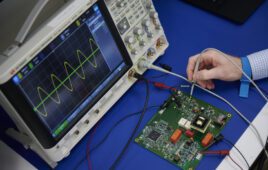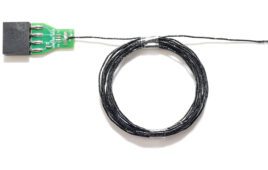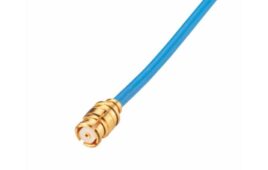Continued improvements in hygiene are possible, along with lowered risk of infection, by using specific materials in the design of modern cable systems.

Lukas von Arx | Director of Sales | LEONI Elocab Ltd
Flexible endoscopy is a frequent diagnostic and therapeutic procedure. But endoscopes are also medical devices often associated with infections in hospitals.
The transmission of bacteria, viruses, and spores by endoscopes can result in serious infections that must be avoided under all circumstances. Efficient sterilization after every use is mandatory for flexible endoscopes that enter or penetrate the mucous membrane (as in the case of biopsy or gastroscopy). Strict rules and standards govern the cleaning and disinfecting of these devices.
Due to their structure, most endoscopes have grooves, crevices, and gaps that make straightforward cleaning difficult. Furthermore, materials in an endoscope’s individual components that do not tolerate heat or chemicals make them unsuitable for particular sterilization processes and hence difficult to clean. This allows for an increased risk of infection transmission.
The FDA and endoscope manufacturers require the highest cleanliness, so suppliers must develop and produce components with a focus on efficient preparation—a proper sterilization.
How geometry improves hygiene
While the main focus of sterilizing endoscopes is on the endoscope channels and instruments, the same strict preparation criteria also apply to connection hoses and other leads. Steam or chemical sterilizations are preferred methods. The endoscope cables and connected components must withstand several hundred cycles using these sterilization methods. Along with materials, the design and structure of a modern cable system can contribute to the proper sterility of a flexible endoscope.
Grooves, gaps, and cavities in the connection of flexible endoscopes can be avoided by overmolding the connection, thereby making the system nearly 100% sealed. Combined with a silicone jacket and LSR molding, the endoscopy system can then be exposed to safe and durable sterilization for up to 1,000 cycles in an autoclave while maintaining optimized gliding properties.
The technology means endoscopic systems are bound to have grooves and crevices. For instance, a connection between different materials often leads to problems when connecting plugs or ferrules. When metal and plastic parts in an assembly come into contact, a biofilm can form in cavities or recesses that provide fertile ground for microorganisms.
Such gaps and holes at connection points can be prevented by applying a special overmolding technology. The penetration of fluids can also be prevented at these points. Overmolding with a silicon-based material can eliminate grooves and crevices, and achieve a nearly 100% seal in these tricky locations. Built-in connectors are also molded with materials such as an epoxies and silicones.
With several materials to choose that make good seals mean standards can be established in the manufacturing plans for endoscope cable systems that enable lasting sterilization of a complete endoscopy system. Thanks to biocompatible silicon jackets with a nearly 100% seal, endoscopy cable systems can withstand up to 1,000 autoclave cycles at 290°F. Comparable results also come from the use of other biocompatible materials, such as thermoplastic polyurethane (TPU), ethylene tetrafluorethylene (ETFE), and fluorinated ethylene propylene (FEP).
Few limits in cable design
The key function of an endoscope is to provide the best possible image resolution to ensure fast diagnosis and proper treatment. The reliable transfer of video signals is a necessity.

Shown separately, a hybrid endoscopy cable would have a data cable (left) and fiber bundle for video signals extruded in a shared jacket.
Image and video transmissions are based on copper and fiberoptics. The CCD, chip-on-the-tip and CMOS-based 3D, high-end endoscopes of various manufacturers are deployed with differing transmission systems. These latter devices will help select a preferred cable design.
Copper cables are flexible and provide a strong and reliable signal transfer. On the other hand, fiberoptics provide greater bandwidth together with a small diameter. Fiberoptics also save weight and protect against sources of interference (EMI). For example, while a bronchoscopy system in development may be focused on a minimal outer diameter, a high level of illumination is essential for laparoscopy along with reliable signal transmission. Technologically sophisticated hybrid cable structures facilitate the integration of copper, fiberoptic, fiber-bundle elements, and hoses.
Hybrid round cables that include copper components and fiber-optic conductors can run in parallel in a shared and extruded jacket. An integrated fiber bundle transmits light to the surgical site, while the fiberoptic conductor transfers the signal from a 3D camera to the monitor. Copper components supply electrical power.

The endoscopic cable provides separate video and data channels in a common extrusion that allows a thorough sterilization.
Only a few cable specialists are versed in the development and production of such customized cable solutions, in addition to making copper and fiber-optic cables. Upon customer request, such solutions can be fitted with power, signal, data, and light-transmission components as well as polyurethane hoses. Additional application-optimized connections are possible, thanks to cables miniaturized down to AWG 50, as well as micro-soldered connections as small as AWG 44.
Lastly, regarding component tests, endoscopic cable systems that provide optimum image quality and can be sterilized are checked in standardized and specialized function tests. Among other aspects, the number of fibers, distribution, light loss, and impermeability of the light source as well as suitability for certain sterilization methods are established in a special fiber-bundle test.




